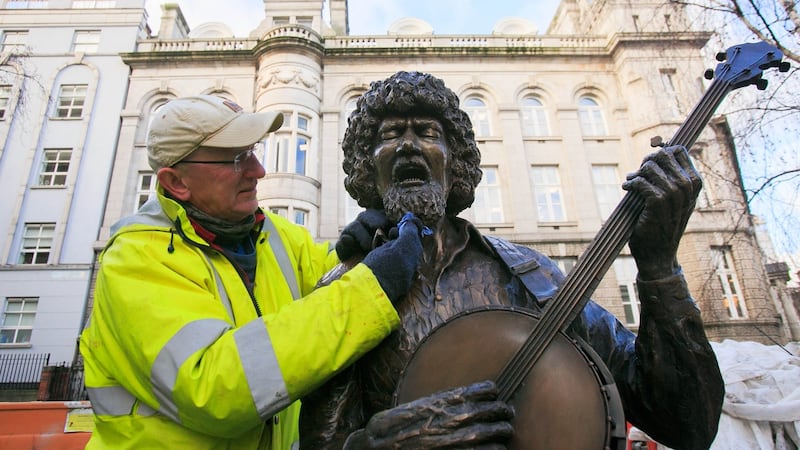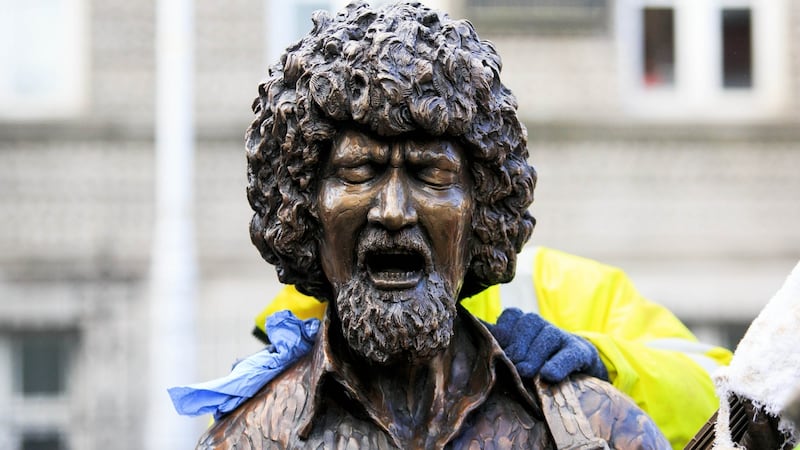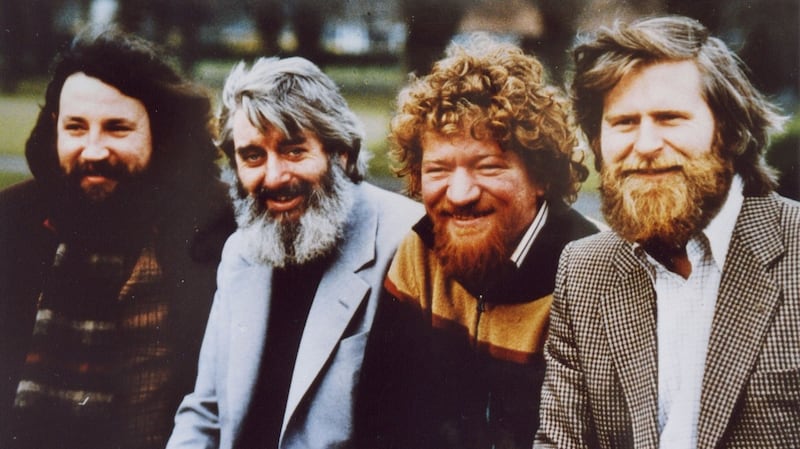You wait years for a Luke Kelly statue, and then two of them come along at once. Tomorrow, the city unveils two separate sculptures, on either side of the Liffey, of the quintessentially Dublin singer, folk musician, social activist and actor – marking the 35th anniversary of his death.
The celebratory double take of Luke Kelly, a founder member of The Dubliners, came about as a piece of serendipity. In 2004 Dublin City Council (DCC) passed Cllr Christy Burke's motion proposing to commission a statue of Luke Kelly for the city, but those plans collapsed along with the economy in 2008.
When Christy Burke became Lord Mayor in 2014, commissioning the Luke Kelly statue was one of his aims. From a competition for the sculpture, Vera Klute's proposal was selected. The German-born, Dublin-based artist's sculpture is an enormous – more than 2m high – Kelly head (his red hair and beard were distinctive).
Made of marble and metal, it is freestanding and mounted on a large concrete plinth along the Royal Canal in the north inner city docklands (near Kelly's birthplace). The pose is based on a performance of Scorn not his Simplicity on the programme The McCann Man in 1974, and has Kelly with his eyes closed, immersed in the song with his head tilted downwards. It will be unveiled on Wednesday at 3.30pm.
Klute says Kelly “generated a raw, intimate response – that’s what I wanted to achieve. For me it’s all about the face, the passion and the emotional connection. By stripping the sculpture down to just that and making this expression huge, I want to confront people with that energy and intensity.”
Klute sought to make the sculpture visually very distinctive, “just like Luke’s own appearance”. “Once you’ve seen it, you won’t forget it, and you couldn’t mistake it for anyone else,” she says.

Separate from the city council's initiative, another sculpture was also in the works. Gerry Hunt, retired architect and lover of folk music – Luke Kelly's in particular – commissioned sculptor John Coll to make a seated figure of Kelly for his Drumcondra garden.
As it neared completion, he offered the sculpture to Dublin citizens via Dublin City Council. Hunt died last summer, before his Kelly statue settled into its home today on South King Street, a position favoured by Hunt and the Kelly family, and an area associated with Kelly as a musician and Dublin figure.
It will be unveiled at 2pm on Wednesday.
Coll’s life-size figurative piece in cast bronze is of a cross-legged, wild-haired Kelly in full flight on his five-string banjo. He’s wearing flared slacks, a wing-necked shirt collar and “Monkey boots” of Kelly’s era.

Coll says he found Des Geraghty’s memoir of Kelly “very insightful. Visual images of Luke abound, and having a strong bone structured face and a unique hair style, all made the basic elements of the face easy to capture”.
But Coll was after Kelly’s “elusive nature” and “unique texture” . “The way Luke performed his music was unique. The intensity of purpose, the emotional charge, the texture of his voice, were completely his own.”
Coll's Patrick Kavanagh on his canalside bench is a Dublin landmark, as his Brendan Behan is on the Royal Canal, just off Dorset Street.

Considered one of Ireland’s greatest folk singers, Luke Kelly built his career on an ability to connect through story and song, from the streets of north Dublin to stages all over the world. He had a significant impact on the 1960s and 1970s Dublin and Irish music scene.
Born on Sheriff Street in Dublin city into a working-class family, he moved to England in his late teens, where he got involved in folk music and was influenced by Ewan MacColl.
Back in Dublin in the 1960s, he became a founding member of The Dubliners, for whom he played the banjo and sang. He played with them for 19 years.
Kelly was known for interpretations of songs including On Raglan Road, Scorn Not His Simplicity and The Town I Loved So Well. As an actor he played King Herod in the musical Jesus Christ Superstar (produced by Noel Pearson in 1973 in the Gaiety). He died on January 30th, 1984 and is buried in Glasnevin Cemetery.
Family friend and author of Luke Kelly A Memoir, Des Geraghty says of him: "The voice of Luke Kelly rang out loud and clear in the early 1960s to lift up the heart and soul of a dismal Dublin city. He captured the latent spirit of the Irish people and gave new hope and inspiration to the poor and oppressed in many a distant land. Like Joe Hill, the great American union organiser and folk singer, his voice and passion for justice and liberty will never die."
Dublin City Council is hosting a concert in Liberty Hall, Dublin on Wednesday, January 30th, marking the statues and celebrating Luke Kelly's contribution to Dublin and to Irish music. Guests include John Sheahan, the last surviving member of The Dubliners, musician and actor Glen Hansard, spoken-word artist Natalya O'Flaherty and singer/songwriter Damien Dempsey. Also onstage are musician Andy Irvine, multi-instrumentalist Finbar Furey, singer-songwriter Aoife Scott, Ian Lynch of Lankum, and George Murphy. (Tickets €11.80 including fee from Ticketmaster. From 8pm)
President Michael D Higgins will unveil both statues, in the presence of Dublin Lord Mayor Nial Ring. The John Coll statue will be unveiled at 2pm on South King Street. The Vera Klute sculpture will be unveiled at 3.30pm on Royal Canal, Guild Street/Sheriff Street.










